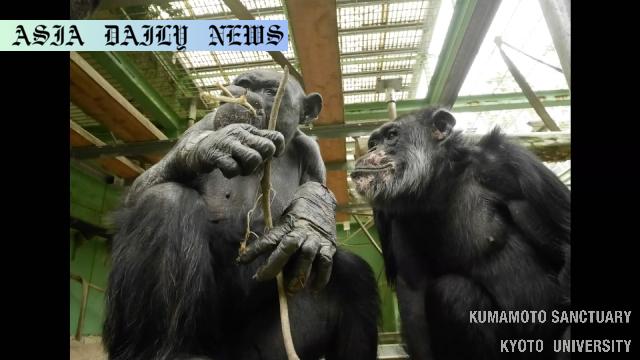A Japanese study reveals contagious urination behavior seen in chimpanzees, potentially a social imitation mechanism.
A study revealed that urination is contagious among chimpanzees, similar to other imitation behaviors.
Close proximity among the chimps increases the likelihood of copycat urination.
Lower-ranked chimps are more prone to this behavior, hinting at social bonding motives.

Introduction to the Study
Chimpanzees, our closely related primates, exhibit a wide range of social and group behaviors. One such intriguing behavior, as unraveled by researchers from Kyoto University’s Wildlife Research Center, is contagious urination. Similar to humans who often yawn upon seeing someone else do so, chimpanzees appear to mimic urination patterns in group settings. This phenomenon, highlighted in a recent study, provides a fascinating glimpse into their unique social dynamics and group interactions.
The Research Methodology
Conducted at Kumamoto Sanctuary in southwestern Japan, the study entailed over 600 hours of observation of 20 captive chimpanzees. Researchers meticulously noted instances of urination, distances between the chimps, and their social hierarchy. Data revealed significant patterns: chimpanzees in closer proximity to an initial urinator were more likely to follow suit within a brief span of three minutes. This contagious behavior was distinctly stronger for those within 50 to 60 centimeters compared to those further away, indicating the critical role of physical closeness in triggering the response.
Connections to Social Hierarchy
The study further unearthed an interesting connection to social hierarchy. Lower-ranked members of the group exhibited a higher propensity for this copycat behavior compared to their dominant counterparts. This finding hints at the potential motive behind this behavior: establishing bonds or gaining acceptance within the group. Mimicking such fundamental actions may serve as a subtle form of communication and reinforcement of social ties.
Contagious Actions in Primates
This phenomenon aligns with other observed contagious behaviors in chimpanzees, such as yawning or stretching. These behaviors are believed to play an essential role in social bonding and group cohesion. While yawning might help the group synchronize activities and alertness levels, urination imitation could be linked to maintaining harmony and strengthening relationships in close-knit groups.
What Drives This Behavior?
Even though the study establishes patterns and the frequency of such synchronized peeing, the underlying reasons remain unclear. Lead researcher Onishi Ena proposes a hypothesis: this behavior might be an unconscious attempt to deepen social bonds. Lower-ranked individuals, particularly, may utilize such interactions to navigate their place within the group and foster connections with higher-ranked members.
Implications of These Observations
Understanding this behavior not only sheds light on chimpanzees’ social intelligence but also draws parallels to human behavior. Humans often use imitation, even seemingly trivial ones, to build rapport and foster connections. By studying such instances in chimpanzees, researchers can better understand the common evolutionary threads that connect humans and primates, offering deeper insights into the development of social relationships.
Conclusion and Future Prospects
Though contagious urination may seem like an unusual subject of study, it opens the door to broader research into group dynamics, imitation, and social behaviors in primates. Such studies pave the way for exploring social communication methods not only among chimpanzees but in other primates and animals as well. Additionally, they highlight the nuanced ways in which animals communicate, bond, and maintain group cohesion. Future research might uncover the role of this and similar behaviors in wild chimpanzee communities, providing a richer understanding of their complex social lives.



Commentary
Exploring the Fascination of Contagious Behavior
The study of contagious urination among chimpanzees offers a unique and intriguing glimpse into the complexity of primate social behavior. On the surface, mimicking something as simple as urination might appear trivial, but it underscores a broader evolutionary mechanism: the importance of imitation in group dynamics. While humans might not consciously notice, subtle mimicking actions are often employed in daily interactions to foster rapport — a behavior clearly evident in our close primate relatives.
The Role of Social Status and Bonding
What I find particularly compelling is the role of the social hierarchy as it ties into this behavior. Lower-ranked chimpanzees, seemingly the more ‘submissive’ members of the group, participate in this pattern more frequently. This raises fascinating questions. Are they trying to signal loyalty, comply with dominant members, or simply integrate themselves better into the social setup? Such studies highlight the depth of non-verbal communication in animals compared to our verbal exchanges as humans.
Broadening Research Horizons
While the study presents valuable findings, it also opens a Pandora’s box of questions. Could this behavior be observed in wild chimpanzees? Do other species exhibit similar patterns? The delicate balance between environmental and evolutionary factors deeply influences these behaviors. As research progresses, I hope to see further exploration into how animals develop these mechanisms over generations and adapt to new social challenges.
Ultimately, such research invites us to reflect on our shared behaviors with our primate cousins and appreciate the intricate connections that unite us as part of the animal kingdom.